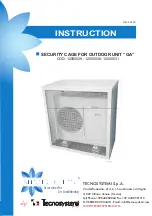
RT-SVX34R-EN
57
Variable Air Volume
Applications (Traditional VAV)
Supply Air Temperature Control -
Occupied Cooling and Heating
The RTRM is designed to maintain a selectable supply
air temperature of 40°F to 90°F with a +/- 3.5°F
deadband. In cooling, if supply air temperature is more
than 3.5 degrees warmer than the selected
temperature, a stage of cooling will be turned “On” (if
available). Then if the supply air temperature is more
than 3.5 degrees cooler than the selected temperature,
a stage of cooling will be turned “Off”.
At very low airflows the unit may cycle stages “On”
and “Off” to maintain an average discharge air
temperature outside the 7 degree deadband.
If the unit has modulating heat, the unit can be made to
do discharge heating with VAV control. This is done by
placing a contact closure across the “Changeover
Input” on the RTAM. During this mode, the unit will
heat to the Supply Air Heating Se/- 3.5°F.
During low load or low airflow conditions the actual
temperature swing of the discharge air will likely be
greater.
The RTRM utilizes a proportional and integral control
scheme with the integration occurring when the supply
air temperature is outside the deadband. As long as the
supply air temperature is within the setpoint deadband,
the system is considered to be satisfied and no staging
up or down will occur.
Supply Air Temperature Control with an
Economizer
The economizer is utilized to control the supply air
cooling at +1.5°F around the supply air temperature
setpoint range of 40°F and 90°F providing the outside
air conditions are suitable.
While economizing, the mechanical cooling is disabled
until the economizer dampers have been fully open for
three minutes. If the economizer is disabled due to
unsuitable conditions, the mechanical cooling will
cycle as though the unit had no economizer.
VHR Relay Output
During unoccupied mode, daytime warm-up (DWU)
and morning warm-up (MWU) the VFD will open to
100%. All VAV boxes must be opened through an ICS
program or by the VHR wired to the VAV boxes. The
RTRM will delay 100% fan operation approximately 6.5
minutes when switching from occupied cooling mode
to a heating mode.
Zone Temperature Control without a
Night Setback Panel or ICS - Unoccupied
Cooling
When a field supplied occupied/unoccupied switching
device is connected between RTRM J6-11 and RTRM
J6-12, both the economizer and the mechanical cooling
will be disabled.
Zone Temperature Control without a
Night Setback Panel or ICS - Unoccupied
Heating
When a field supplied occupied/unoccupied switching
device is connected between RTRM J6-11 and J6-12
and DWU is enabled, the zone temperature will be
controlled at 10°F below the Morning Warm-up
setpoint, but not less than 50°F, by cycling one or two
stages of either gas or electric heat, whichever is
applicable.
Morning Warm-up (MWU) Control
Morning Warm-up is activated if the zone temperature
is at least 1.5°F below the MWU setpoint whenever the
system switches from Unoccupied to Occupied status.
The MWU setpoint may be set from the unit mounted
potentiometer or a remotely mounted potentiometer.
The setpoint ranges are from 50°F to 90°F. When the
zone temperature meets or exceeds the MWU setpoint,
the unit will switch to the “Cooling” mode. The
economizer will be held closed during the morning
warm-up cycle.
Daytime Warm-up (DWU) Control
Daytime Warm-up is applicable during occupied status
and when the zone temperature is below the initiation
temperature. It can be activated or deactivated through
ICS or a night setback zone sensor. If ICS or a night
setback zone sensor is not utilized, DWU can be
activated by setting the DWU enable DIP switch
(RTAM) to ON and supplying a valid morning warm-up
setpoint.
The unit is shipped with a Morning Warm-up setpoint
configured and the Daytime Warm-up function is
activated (switch on). Opening the DWU enable switch
will disable this function.
If the system control is local, the DWU initiation
setpoint is 3°F below the Morning Warm-up setpoint.
The termination setpoint is equal to the Morning
Warm-up setpoint.
If the system control is remote (Tracer™), the DWU
setpoint is equal to the Tracer Occupied heating
setpoint. The initiation and termination setpoints are
selectable setpoints designated by Tracer.
When the zone temperature meets or exceeds the
termination setpoint while the unit is in an Occupied,
“Auto” Mode or switched to the “Cooling” Mode, the
unit will revert to the cooling operation.
Summary of Contents for Voyager Commercial
Page 153: ...RT SVX34R EN 153 N No ot te es s...
Page 154: ...154 RT SVX34R EN N No ot te es s...
Page 155: ...RT SVX34R EN 155 N No ot te es s...
















































